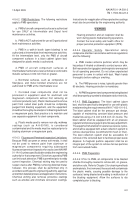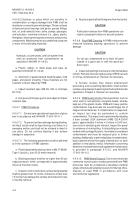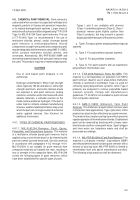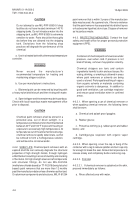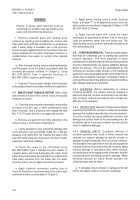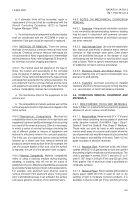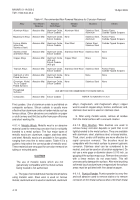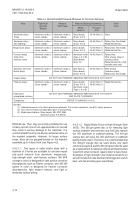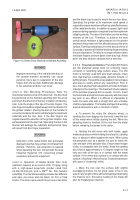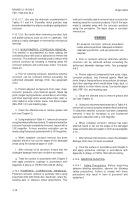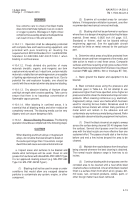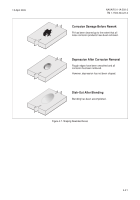TM-1-1500-344-23-2 - Page 89 of 240
4-13
NAVAIR 01-1A-509-2
TM 1-1500-344-23-2
15 April 2009
WARNING
Improper mounting of the radial bristle disc on
the grinder-mandrel assembly can cause
personal injury due to separation of the disc
fingers from the tool hub. Additionally, damage
to the substrate and disc can occur.
4-9.2.1.3. Disc Mounting Procedures. Note the
directional rotation arrow on the disc hub. The disc must
be positioned on the mandrel assembly with the arrow
pointing in the direction of the tool’s rotation (clockwise).
Also, note the angle of the tips of the disc fingers. The
disc fingers should be angled away from the direction of
the grinder rotation. Placing the disc on the mandrel in
a counterclockwise direction will damage the aluminum
substrate and the tool. Also, if the disc fingers are
angled toward the direction of the grinder rotation, they
will separate from the disc hub. Operating the tool in this
manner will damage the substrate and personal injury
will result from disc finger separation.
WARNING
Utilization of the radial bristle disc generates
dust particles that may contain chromates from
primers. Therefore, eye protection is required
when operating this tool. Consult with the local
Industrial Hygienist (IH) concerning proper
respiratory protection equipment.
4-9.2.1.4. Operation of Radial Bristle Disc.
Disc
operation requires an air source of 90-110 psig, along
with a high-speed pneumatic grinder rated from
20,000-25,000 rpm and a 3M™ No. 990 mandrel
assembly. The mandrel assembly includes two different
end caps, one silver and one black, for thin or thick
stacks. The silver cap is used to mount one or two discs
and the black cap is used to mount three or four discs.
Operating the grinder at its maximum rated speed is
required to ensure maximum efficiency and effectiveness
of the radial bristle disc. In addition to speed, light hand
pressure during operation is required to achieve optimum
stripping results. The tips of the bristles are the working
element of the tool. Therefore, to achieve the best
overall result, maintain a light pressure on the grinder
and move the grinder over the affected area on the work
surface. Exerting hand pressure on the disc at a force of
2 pounds or greater will fold the bristle tip fingers making
the tool inoperative. The disc is no longer effective when
the bristle fingers are worn down to the disc hub. At this
point, the disc must be replaced with a new disc.
4-9.2.2. Pneumatic Drill Motors. Pneumatic drill motors
are the preferred power tools for removing heavy
corrosion or reworking large surface areas. The drill
motor is normally used with wire brush wheels, rotary
files, flap brushes, sanding pads, abrasive wheels, or
buffing wheels. These drills are available in many shapes
and sizes to satisfy almost any requirement. Prior to
use, check all pneumatic equipment air hoses for breaks
or bulges in the coverings. The maximum chuck capacity
of the portable powered drill is usually 1/4 inch. Insert
the tool shank and tighten chuck securely with the chuck
key prior to use. When it is difficult or impossible to
reach the work area with a straight drill, use a flexible
shaft or angle adapter. The flexible shaft permits working
around obstructions with a minimum of effort.
a. To prevent the rotary file, abrasive wheel, or
sanding disc from digging into the metal, keep the tool
off the metal when initially starting the drill. When the
abrading stroke is finished, lift the tool from the metal
before releasing the power to the motor.
b. Holding the drill motor with both hands, apply
moderate pressure while holding the rotary file, sanding
disc, or abrasive wheel against the work. When using
the pneumatic tool as a sander, be sure to check the
size and type of the abrasive disc. Ensure that the type
of disc is compatible with the metal. Keep the sanding
disc tilted to approximately a 10 degree angle so that
only one side of the disc is in contact with the metal
surface. If the entire disc surface is in contact with the
surface, a "bucking" effect will occur. Excessive pressure
will cause a "chattering" effect.
c. Move the tool over the surface with slightly
overlapping strokes. Do not grind, sand, or file in one
area for any length of time without stopping and allowing
the metal to cool. Excessive heating of the metal will
alter its metallurgical structure.
Figure 4-2. Bristle Discs Stacked on Mandrel Assembly
Back to Top

